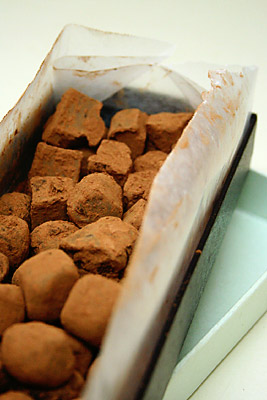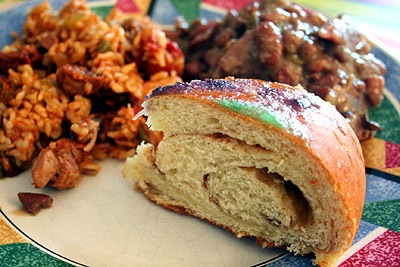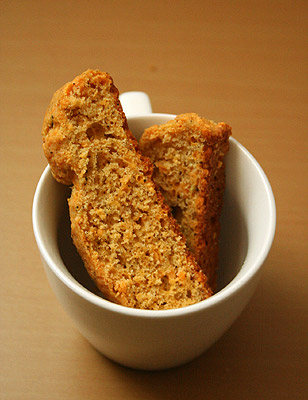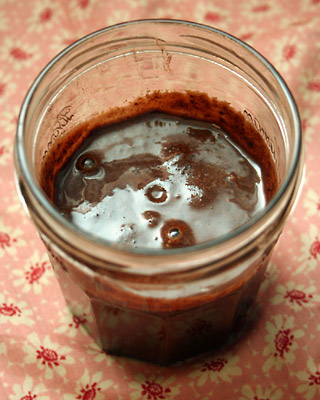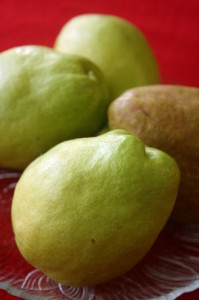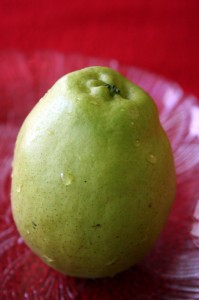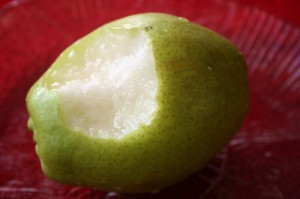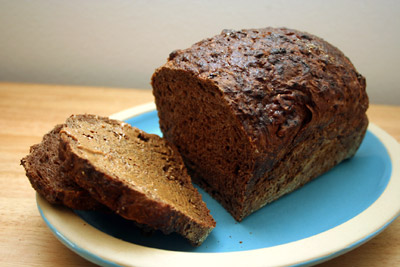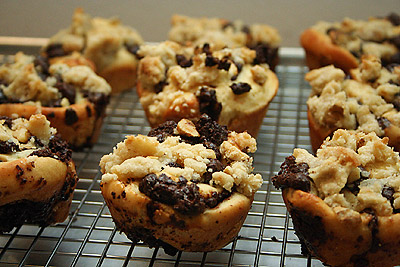
For years, I’ve fantasized about the perfect chocolate babka. Maybe it’s because my parents always packed me plain Cheerios and All Bran sticks for breakfast. Babka would have been out of the question. Too much chocolate. Too much sugar. Too much butter.
But anything else would be poser babka. My idea of babka involves a danish-like dough and layers of chocolate in every bite. There’s so many versions of babka, though, that it’s easy to get lost. The Russians, Polish and Jewish all have their variations. Fortunately, Smitten Kitchen pointed me to Martha Stewart’s recipe, which has 2 1/4 pounds of chocolate and 5 sticks of butter. It makes three loaves, so one loaf “only” has 3/4 pound of chocolate and a 1 2/3 sticks butter.
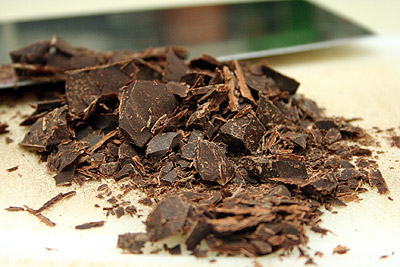
 I know I wanted chocolate and butter but not that much. I significantly reduced the butter, but to keep the dough moist and soft, I added mashed potatoes. (You can enrich any bread with mashed potatoes, as long as it’s about 1/3 the weight of the flour. Potato starch works magic in the dough.) Since World Nutella Day is Feb. 5, I attempted a Nutella babka.
I know I wanted chocolate and butter but not that much. I significantly reduced the butter, but to keep the dough moist and soft, I added mashed potatoes. (You can enrich any bread with mashed potatoes, as long as it’s about 1/3 the weight of the flour. Potato starch works magic in the dough.) Since World Nutella Day is Feb. 5, I attempted a Nutella babka.
This recipe is a work in progress. This potato bread version isn’t as rich as danish, but with all that chocolate, I don’t mind. If you want real babka, by all means, use 1 2/3 stick of butter (and omit the mashed potatoes.) Also, baking Nutella breaks down its smooth texture and hazelnut flavor, so the filling wasn’t quite how I wanted it.
The version pictured above was baked in muffin tins, but I recommend using a loaf pan. You want the filling to stay moist, and if it’s exposed to too much heat, it will turn grainy and possibly burn.
Nutella Babka
Adapted from Martha Stewart
Makes 1 loaf
This babka has never-ending folds of chocolate. I like to unravel every spiral and chew through the long strip. It’s more fun to eat, and it lasts longer that way. Please excuse the funny measurements; I scaled down the recipe so it makes a more manageable amount.
For dough:
1/2 cup cooked mashed potato (see instructions below)
1/2 cup lukewarm buttermilk or potato water, 110 degrees
1 2/3 teaspoons active dry yeast
1/4 cup plus a pinch of sugar
1 large egg, room temperature
2/3 large egg yolk, room temperature
2 cups all-purpose flour, plus more for work surface
1/3 teaspoon salt
2 tablespoons (1/4 stick) unsalted butter, cut into 1-inch pieces, room temperature
For filling:
7 ounces (about 1 1/6 cup) very finely chopped bittersweet chocolate (or 6 ounces 60% chocolate and 1 ounce unsweetened chocolate)
1/4 cup plus 2 tablespoons Nutella
2 1/2 teaspoons ground cinnamon
For glaze:
1 teaspoon milk
Some reserved egg from the dough
For streusel:
1/2 cup powdered sugar (or 1/4 cup granulated sugar)
1/3 cup plus 1/9 cup all-purpose flour
1/4 teaspoon salt
1/2 cup lightly toasted hazelnuts, coarsely chopped
4 tablespoons (1/2 stick) unsalted butter, room temperature
Make dough:
Peel, cube and boil (until soft) one small potato, weighing about 3 ounces, in just enough water to cover. Strain out the potato pieces and mash them with a fork. Set aside the potato and water to cool. Freeze any extra water in ice cube trays. Use potato water in place of the liquid in any bread recipe. It’ll make the dough soft and sweet.
Pour lukewarm potato water or buttermilk into a small bowl. Sprinkle yeast and pinch of sugar over milk; let stand until foamy, about 5 minutes.
In a bowl, whisk together sugar, 2/3 egg, and 2/3 egg yolk. Add egg mixture to yeast mixture, and whisk to combine.
In the bowl of an electric mixer fitted with the paddle attachment, combine flour and salt. Add egg mixture, and beat on low speed until almost all the flour is incorporated, about 30 seconds. Change to the dough hook. Add 2 tablespoons butter, and beat until flour mixture and butter are completely incorporated, and a smooth, soft dough that’s slightly sticky when squeezed is formed, about 10 minutes.
Turn dough out onto a lightly floured surface, and knead a few turns until smooth. Butter a large bowl. Place dough in bowl, and turn to coat. Cover tightly with plastic wrap. Set aside in a warm place to rise until doubled in bulk, about 2 hours.
Make filling and shape dough:
While the dough is rising, place chocolate and cinnamon in a large bowl. Stir to combine. Stir in the Nutella until well combined.
Generously butter a 9x5x 2 3/4-inch loaf pan line with parchment paper. Beat remaining 1/3 egg with 1 teaspoon milk; set egg wash aside. Gently punch down the dough, and transfer to a clean surface. Let rest 5 minutes. On a generously floured surface, roll dough out into a 16-inch square; it should be 1/8 inch thick.
Brush edges with reserved egg wash. Crumble the chocolate filling (reserve 2 tablespoons) evenly over dough, leaving a 1/4-inch border. Refresh egg wash if needed. Roll dough up tightly like a jelly roll. Pinch ends together to seal. Twist 5 or 6 turns. Brush top of roll with egg wash. Carefully crumble 2 tablespoons filling over the left half of the roll, being careful not to let mixture slide off. Fold right half of the roll over onto the coated left half. Fold ends under, and pinch to seal. Twist roll 2 turns, and fit into prepared pan and cover loosely with plastic wrap.
Make streusel:
In a large bowl, combine sugar, flour, salt, hazelnuts and butter. Using a fork, stir until fully combined with clumps ranging in size from crumbs to 1 inch.
Squeeze the streusel in the palm of your hand so large clumps remain. Uncover the loaf and brush the top with egg wash. Sprinkle the streusel on top. It will seem like you have too much streusel, but pack it in there. The dough will expand later. Re-apply the plastic wrap and let stand until the dough reaches the top of the pan and is about doubled in volume, about 1 hour.
Bake loaf:
Fifteen minutes prior to baking, preheat the oven to 350F. Bake until the top is golden brown and the bottoms sound hollow when tapped (when loaf is removed from pan), about 40 minutes. If the top browns too quickly, cover the loaf with aluminum foil.
Transfer to wire rack and cool for at least 30 minutes. Remove from pan. Serve slightly warm. Babka freezes well for up to 1 month.




